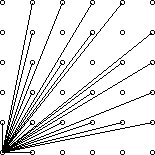Description
A lattice point (x, y) in the first quadrant (x and y are integers greater than or equal to 0), other than the origin, is visible from the origin if the line from (0, 0) to (x, y) does not pass through any other lattice point. For example, the point (4, 2) is not visible since the line from the origin passes through (2, 1). The figure below shows the points (x, y) with 0 ≤ x, y ≤ 5 with lines from the origin to the visible points.
Write a program which, given a value for the size, N, computes the number of visible points (x, y) with 0 ≤ x, y ≤ N.

Input
The first line of input contains a single integer C (1 ≤ C ≤ 1000) which is the number of datasets that follow.
Each dataset consists of a single line of input containing a single integer N (1 ≤ N ≤ 1000), which is the size.
Output
For each dataset, there is to be one line of output consisting of: the dataset number starting at 1, a single space, the size, a single space and the number of visible points for that size.
Hint
N<=1000
Solution
首先需要明确的是,除了(1,0)(0,1)和(1,1)这三个钉子外,一个钉子(x,y)能被看到,当却仅当x,y互质且x不等于y。而容易发现整张图是对称的,所以直接算一半就可以了,从2开始算一直到n的phi的总和,*2再+3((1,0)(0,1)和(1,1)这三个特殊钉子),就是答案了。
#include<cstdio>
#include<iostream>
#include<algorithm>
#include<cstring>
#define maxn 1005
using namespace std;
int num[maxn],primes[maxn],phi[maxn];
int cnt,ans,n,k;
inline void OULA(){
for(int i=2;i<=maxn;i++){
if(!num[i]){
primes[++cnt]=i;
phi[i]=i-1;
}
for(int j=1;i*primes[j]<=maxn;j++){
num[i*primes[j]]=true;
phi[i*primes[j]]=phi[i]*(primes[j]-1);
if(i%primes[j]==0){
phi[i*primes[j]]=phi[i]*primes[j];
break;
}
}
}
}
inline void workk(int x){
for(int i=2;i<=n;i++){
ans+=phi[i];
}
ans*=2;
ans+=3;
printf("%d %d %d
",x,n,ans);
}
int main(){
scanf("%d",&k);
OULA();
for(int i=1;i<=k;i++){
scanf("%d",&n);
workk(i);
ans=0;
}
return 0;
}